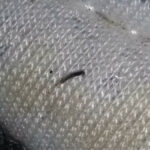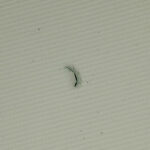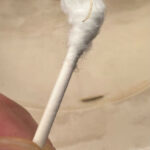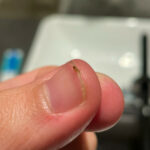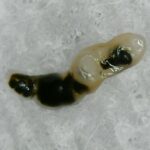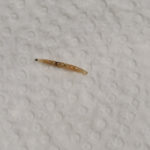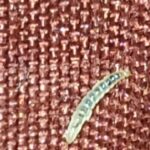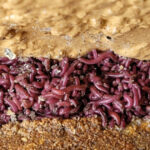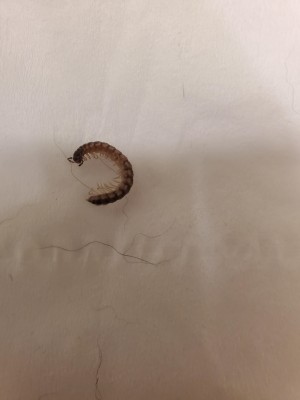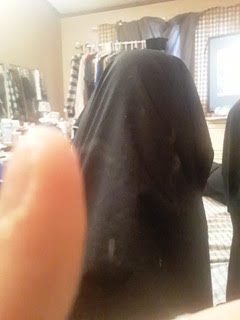
“Do you have any idea what this could possibly be?” asks this reader in her submission regarding the minuscule, translucent, brown creature pictured below. “Watching it, it moves like a caterpillar or worm and will either stand up or put one side up and wiggle into the air. Thanks so much!” First of all, we have to point out the size of the creature. As we can see from the photo, it is very tiny. That tells us that this organism is probably at an early stage of maturation, which means a lot of its defining physical characteristics will not have developed yet. For that reason, whatever identification we end up making is not 100% certain. Secondly, the lack of context also makes it harder for us to say it is any one species for certain.
With all of that said, our best educated guess would be that this is either a fungus gnat larva or a flea larva, just based on the photo. Both of these insect species have larvae whose skin is translucent, which shows their entrails (the dark spot on the creature’s body). That said, the two insects could not be more different. The fungus gnat is a species of fly that will infest compost and other bodies of soil, laying eggs so that their larvae can feed on fungi, mold, and decaying organic materials. They are harmless to humans and animals, but are pests of the garden and terrariums.
Likewise, flea larvae are also harmless to humans and animals, despite their adult counterparts not being so harmless (though most species of fleas found in urban areas will not feed on humans). Flea larvae feed on hair and fur, dead insects, and faecal matter, among other things. For that reason, they are most often found in closets and wardrobes (or anywhere clothing is kept), on beds, or anywhere where a pet spends time (if that is relevant to our reader).
So, for our reader to determine what of the two species this creature possibly could be, she might want to consider where it was found. If it was found in soil, or in or near a houseplant, it could very well be a fungus gnat larva. On the other hand, if it was found near any of the areas relevant to a flea larva, then it could be a flea larva. That said, it could also be neither of the two species. Since it is so tiny, it is difficult to say for certain. If she wants a second opinion, she can always take the critter to her local county extension office to have it physically examined.
In conclusion, the creature our reader found could be a fungus gnat larva, a flea larva, or something else entirely. Even though we were not able to provide a concrete answer to our reader’s question, we hope nonetheless that we were able to help, and we wish her the very best.
All About Worms is always free, always reader-supported. Your tips via CashApp, Venmo, or Paypal are appreciated! Receipts will come from ISIPP Publishing.
You might also find these guys interesting!




